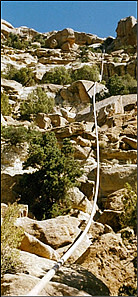Mike-Carlson
Mechanical
- Feb 5, 2017
- 8
Hello everyone,
I have a couple of questions about designing of a horizontal pressure vessel (to be more specific, a pipeline pig receiver) according to ASME Sec 8 div 1. TL to TL length is 12010 mm and, ID is 76.2mm, lethal service, operating pressure is 127.2 barg and operating temperature is 35/52 C:
1- How should I specify the design pressure, MAP and MAWP?
2- Should the vessel be hydro-statically tested in the horizontal condition? if so how should I specify the hydrostatic pressure?
Thank you!
I have a couple of questions about designing of a horizontal pressure vessel (to be more specific, a pipeline pig receiver) according to ASME Sec 8 div 1. TL to TL length is 12010 mm and, ID is 76.2mm, lethal service, operating pressure is 127.2 barg and operating temperature is 35/52 C:
1- How should I specify the design pressure, MAP and MAWP?
2- Should the vessel be hydro-statically tested in the horizontal condition? if so how should I specify the hydrostatic pressure?
Thank you!




